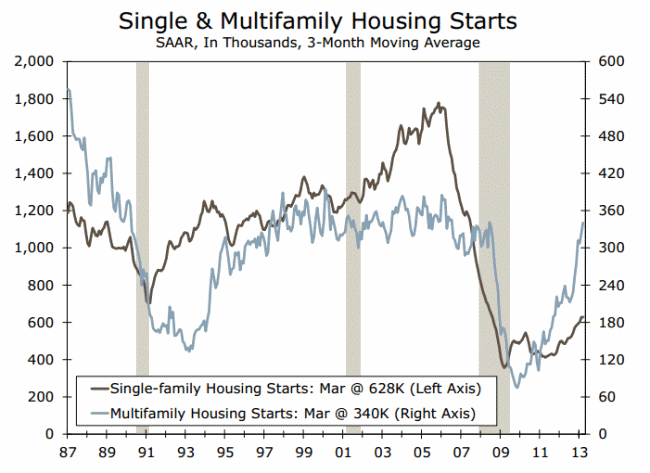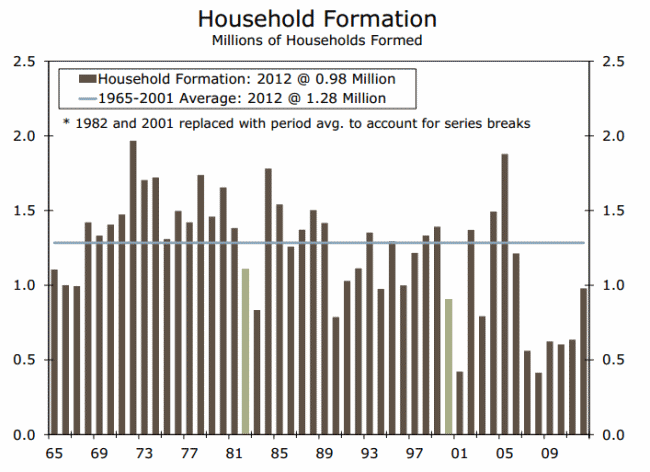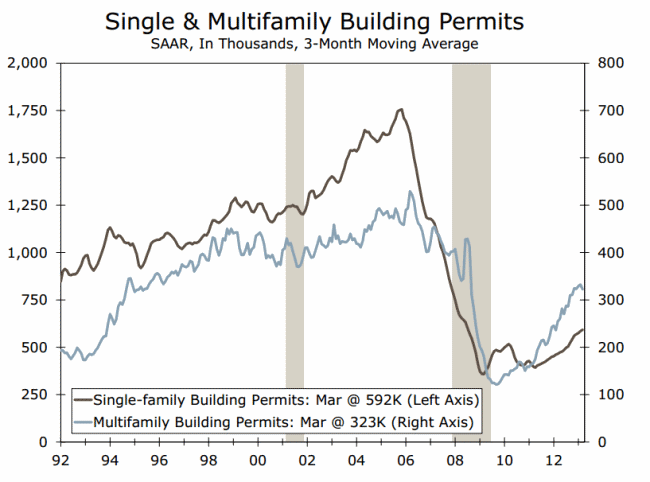In its April Housing Data Wrap-Up Wells Fargo's economists summarize the nation's housing picture: "While most of the housing-related headline numbers continue to improve, the underlying details give us some pause."
One headline, the surprising spurt in housing starts in March. A 1.04 million unit annualized rate marked the highest pace since June 2008. Rising above one-million units was a significant milestone, however the increase was totally in the multi-family sector, and single-family starts fell 4.8 percent.

Another headline is rising prices and tightening inventories. The most recent figures from both S&P Case-Shiller and the National Association of Realtors reflect around 10 percent annual appreciation and as a consequence the percentage of homeowners with negative equity has declined. But much of the impetus behind the rising prices and shrinking inventories, especially in troubled markets like Atlanta and Miami, are sales to investors and cash purchases. Rising prices have outstripped appraisals in some markets, making it tougher for buyers needing a mortgage to buy a home.
Wells Fargo points to other recent causes for concern. One is the recent slide in the Builders Index, a reflection of homebuilders' perceptions of the new home market. After climbing into near positive territory for the first time in six or seven years in early 2013, it has slipped five points over the last three months. Mortgage originations for home purchases are also flat.

The Bank says another disconcerting signal comes from the growing divergence between the homeownership rate and the recent spike in prices. Rising home prices usually coincide with rising demand as more households form or people's preferences swing toward homeownership. The Banks says neither trend appears to be present today. Household formation rose 980,000 in 2012, compared to the long term annual average of 1.28 million between 1965 and 2001. Moreover, the overwhelming majority of new households are choosing to rent rather than own their home. The homeownership rate fell 0.4 percentage points during the first quarter to 65.0 percent and is now at levels last seen in the mid-1990s.


The report points out, "It is hard to imagine a sustainable housing recovery taking place with fewer homeowners." This point, it says, "appears to be lost in all of the celebration over soaring home prices and bidding wars for the scarce inventory of homes currently available for sale." It is important to balance enthusiasm over soaring prices with the knowledge that most of the housing market is still healing and the sharp increases in prices driven partially by both individual and investor purchasing. In contrast to prices, home sales are following a more modest trajectory, one in line with mortgage purchase applications.
One point which tends to be overlooked, the report says, is that a full-fledged housing recovery will require a normally functioning mortgage market and we are nowhere close to one. The Federal Reserve is buying $40 billion in mortgage securities every month, the futures of Freddie Mac and Fannie Mae are uncertain and there are questions related to employment and job creation which have potential ramifications for homeownership.
Wells Fargo says many of the trends it is citing are behind decisions by developers and investors to ramp up construction and purchases of rental properties. They are justified in these decisions as the number of renters has increased by 610,000 in the last year and rental vacancies are down. 0.2 percentage points to 8.6 percent, continuing a four-year slide.
Construction of new apartments is up dramatically, permits during the first three months of 2013 are running 52.7 percent above the same period in 2012. Deliveries of apartment will more than triple by year-end, which should begin to reverse the recent slide in apartment vacancy rates. Even with an increase in deliveries, however, Wells Fargo says it expects multifamily construction to account for a larger proportion of future starts, reflecting more infill development in major areas near where the bulk of jobs are being created.








